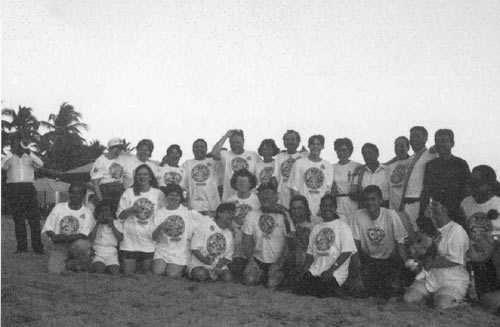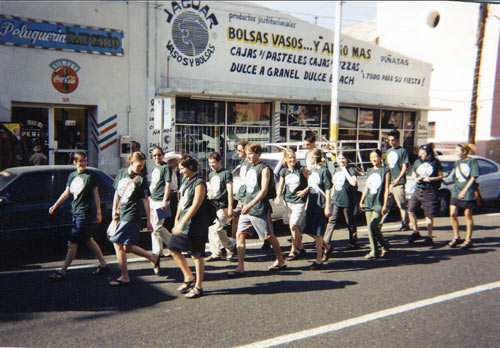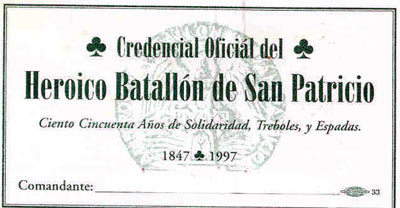|
In
Autumn 1990, I attended a strategy session in
St. Paul,
Minneapolis on how to defeat the proposed free trade agreement between
Canada, the United States and Mexico, known as NAFTA, the North American Free Trade Agreement.
There I met a man named Tom Laney who worked at a Ford
production plant in St. Paul
and was building relations between his UAW local union and the
Ford workers at the Cuautitlán plant outside Mexico City, who were organising a union.
Tom
told me story. He said there were a group of Irish soldiers
who switched sides and fought with the Mexican army against
the US forces in 1847. I said that I didn't believe him. He said that
there was a large plaque honouring their solidarity at the
Plaza de San Jacinto on the outskirts of Mexico City. I still didn't believe him. He said that he had a photograph
of the plaque and I told him to send it on to me.
I
returned home to Olympia, Washington
and to my work at the Evergreen State College as a faculty
member and as the Director of the Washington State's only Labor Education and
Research Center.
A
few days later, Tom's photograph arrived. At the top of the
plaque was the symbol of the battalion, a Mexican eagle over a
Celtic cross. Under the battalion symbol, the plaque read: 'In
memory of the Irish Soldiers of the Heroic Battalion of St.
Patrick martyrs who gave their lives in the cause of Mexico during the unjust North American invasion in 1847.' There were
71 names chiselled in stone.
I
read those names and Mexico became a different place for me. I had never been to
Mexico. I had no desire to be yet another gringo
tourist. Now, however, I felt like I had a real connection, a
legitimacy, a reason to go, a place in history. After all,
there were no Leahys on that plaque, and they must have been
there. I needed to do some research.
Researching
the Battalion
I
asked my staff and students at the Labor Education Center to research the battalion. They found books, dissertations,
essays, novels, and stories. There was history, but like a lot
of interesting history it was buried and out of print.
There
were a lot of arguments about why the Irish soldiers had
switched sides. They were Catholics. The Mexicans were
Catholic. The US Army was Protestant. They didn't much care
for slavery. Mexico
had outlawed it, but the US wanted to expand it by taking Mexican land. Some said it was
the brutal conditions in the US army; some said they were drunk; others said it was the señoritas.
All those reasons sounded good to me. This war had the highest
desertion rate in US history for good reason.
In
August 1991, I flew to Zacatecas, Mexico, for the third round of the NAFTA negotiations. It was my
first trip to Mexico and much to my surprise, I found a town
full of cowboys and farmers who looked a lot like my Irish
uncles in Eastern Washington, except, of course, that the
Zacatecans spoke Spanish. I also met organisers from an
independent labour federation called the FAT which had
organised the alternative 'people's forum' that I was
attending.
The
Labor Center Mission
When
I returned from Zacatecas, I organised a Labor Education Center
mission to develop relations with the FAT. We arrived in Mexico City
in mid-March 1992, a few days before St. Patrick's Day. There
were five of us from the Labor Center, myself, Ellen Shortt, Mary Rose Livingston, Kathleen Byrd
and Helen Lee. Tom and Barb Laney soon joined us from St. Paul. We were hosted by a cadre of union organisers and Ford
workers from the Cuauitlán plant.
|

The revived Batallón at
San Patricio/Melaque, 1995
|
We
visited the Museum of Anti-Interventions in Churubusco. The Convento de Churubusco was the site of the
last battle of the battalion in the war of 1847. Outside the
walls of the Convento were markers honouring the battalion.
After we toured the museum with its history of foreign
invasions, we were walking around outside and discovered a
side street, right in front of the museum. It was a street
named after 'Capitán John O'Reilly, Cmdte, Batallón de San
Patricio.' History was coming alive.
Our
hosts took us up to Plaza San Jacinto on St. Patrick's Day,
and Mexican historians recounted to us the battalion's history
as we sat in their barracks, now a furniture store.
Afterwards, we sat in the square, as our friends played
Mexican ballads. Somehow our hosts found a bottle of Jameson
whiskey and we drank it until the police arrived. They were
Irish, though, so we returned to our hotel rather than the
police station.
Reviving
the Battalion
When
we got back home to Olympia, we started to see the Irish everywhere in Mexican history.
Not only were there the battalion members in 1847, but sixty
years later there were revolutionary heroes like Dorete
O'Arango, Emilián O'Zapata, Alvaro O'Brien and the longest
lasting of them all, Genoveso de la O! We also heard that the
descendants of the battalion had been meeting with the great Lázaro
Cárdenas just before he nationalised Mexico's oil on 18 March 1938.
We
also noticed that many of the organisers in Canada
and the United States who were making alliances with the Mexicans to oppose the
NAFTA were Irish. All of a sudden, we realised that the
battalion was still alive building links between the two
peoples. When our most famous baseball star, Edgar Martínez,
opened negotiations with the Seattle Mariners management, he
reportedly started off by demanding the renegotiation of the
Treaty of Guadalupe Hidalgo, the treaty that ended the US
invasion of Mexico in 1847.
Setting
up the Organisation
Being
organisers, we decided to form an organisation, the Heroico
Batallón de San Patricio, dedicated to celebrating and
expanding links between the Irish and the Mexicans. We set up
a non-profit corporation and opened a bank account. We created
stationery with the battalion symbol and a list of comandantes
down the left-hand side. We took 'Solidaridad por la Libertad
de un Pueblo' as our slogan. We printed and laminated official
wallet-sized credentials making us all 'comandantes,' stamped
'Priority.' We ordered T-shirts with the battalion symbol made
by Cmdte. Ricardo in Minneapolis, and developed a book list of required reading.
Then,
of course, we made up rules. Comandantes had to have at least
four names. Each comandante took on a 'cargo'
- an area of responsibility - a way of shifting resources from
north to south. Comandantes could only show their credentials
when necessary and they needed to attend their daily mass. |



